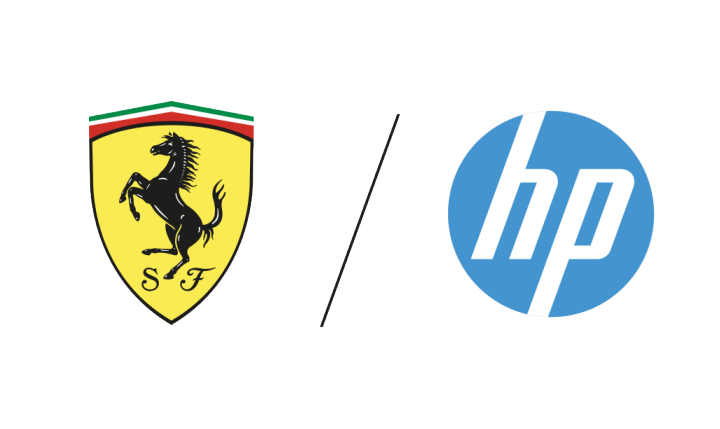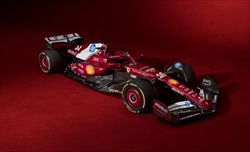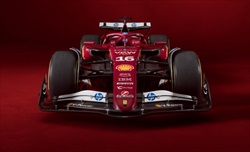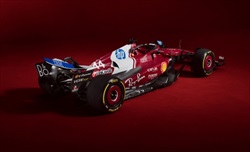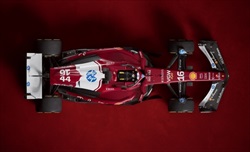Scuderia Ferrari HP
Ferrari SpA
Via Ascari 55-57 - 41053 Maranello, Modena,Italy
Tel: +39 0536 949 111 - Fax: +39 0536 949 436/488
formula1.ferrari.com

Team Chief: Frederic Vasseur
Technical Chief: Enrico Gualtieri e Loic Serra
Sports Director: Diego Ioverno
Chassis 2025: SF-25
Engine: FerrariTyre: Pirelli
Reserve Driver: Bearman Oliver
Season 2025
The Scuderia Ferrari, faces the new 2025 season with the stated goal of continuing its growth process under the leadership of Frederic Vasseur, and after finishing second in the 2024 Constructors' Championship improving means bringing the World Title back to Maranello and fighting for first place in the Drivers' one as well.
In 2025 Lewis Hamilton will join Charles Leclerc, replacing Carlos Sainz, bringing the experience and talent of a seven-time World Champion.
The new car, dubbed Project 677, will be more than an evolution of the SF-24 as it will inherit virtually no components from the previous single-seater, with major aerodynamic and mechanical changes, according to the team principal's statement. The new design introduces a pull-rod suspension system at the front to improve aerodynamic and dynamic performance; in addition, there will be major changes to the driver's position and the gearbox. After consistent race performance in 2024, next season the team aims to improve performance in qualifying and further reduce tire degradation under certain conditions
At the O2 Arena in London on Feb. 18, Scuderia Ferrari HP presented the livery of the new single-seater in the presence of CEO Benedetto Vigna, Team Principal, Fred Vasseur, and drivers Charles Leclerc and Lewis Hamilton. Immediately afterwards, the team released imams and videos of the 2025 single-seater, the SF-25
History
Scuderia Ferrari is an Italian racing team, now the sports section of the Ferrari car manufacturer.
Founded by Enzo Ferrari in 1929, over the decades it has established itself as one of the best known and most successful teams in world motorsports. It has mainly linked its name to the Formula One World Championship, in which it has been present since its inception and in which it has won the Drivers' Title 15 times and the Constructors' Title 16 times. It has also reported numerous successes in competitions for Sport Prototype and Grand Touring cars such as the World Sport Prototype Championship, where it has won 12 Constructors' Titles, and endurance races such as the 24 Hours of Le Mans, the 24 Hours of Daytona and the 12 Hours of Sebring. His most prestigious triumphs include victories in the world's three major road course competitions namely the Targa Florio, the Mille Miglia and the Carrera Panamericana.
From 1929 to 1937 it was set up by the S.A. Scuderia Ferrari, which raced cars supplied exclusively by Alfa Romeo, representing the racing department of the “biscione” car manufacturer. In 1939, after two years of suspension of racing activity, the team was reborn, this time independently, under the name Auto Avio Costruzioni, and from 1947 it resumed the name Scuderia Ferrari. The division of Ferrari to which the set-up of the Scuderia Ferrari is delegated is Gestione Sportiva; support to teams and customers competing with their own Ferrari cars is delegated instead to the Ferrari Corse Clienti division.
As a result of sponsorship or technical cooperation contracts, the name of the sponsor of the day may be attached in the team's name. As of 2013, it is the richest motorsports team among those in Formula 1 and NASCAR, also ranking 21st on the list of the 50 richest sports companies on the globe, with a total value estimated at $1.2 billion; its advertising contracts with Marlboro, Banco Santander and Shell are worth about $250 million annually.
Enzo Ferrari's idea
In the fall of 1929 Enzo Ferrari had obtained a preliminary promise of participation, from Pirelli and Alfa Romeo, in an eventual racing team. Ferrari's idea was to create a structure outside the two companies that would relieve them of the organizational burdens and costs, transferring them to the gentleman-drivers eager to compete, and to the organizers of the various circuits, who were willing to pay substantial fees in order to have famous drivers who would attract the public. The first accessions were those of brothers Alfredo and Augusto Caniato, gentleman-drivers from Ferrara to whom Enzo Ferrari had just sold an Alfa Romeo 6C 1500 Corsa, willing to shell out a substantial portion of the necessary capital.
The foundation
Palazzo Ghisilardi Fava, where the foundation of the Scuderia was decided.
The opportunity to complete the string of backers presented itself on October 12, during the celebrations for the world speed record achieved at Cremona by Baconin Borzacchini in a Maserati Tipo V4. To celebrate the Bologna-based manufacturer's record, Podesta Leandro Arpinati and the Automobile Club had organized a gala dinner, in the Casa del Fascio in Bologna, to which drivers, political and sports personalities and wealthy enthusiasts were invited. It was at the end of that dinner that Enzo Ferrari and Alfredo Caniato were joined by Mario Tadini, a wealthy driver from Bologna. Caniato and Tadini took on the running costs, and the founding of the team was decided on that evening.
Lawyer Enzo Levi, father of the better-known Arrigo, was appointed to work out the details of the agreement, and he succeeded in composing the burdens, needs and objectives of the various parties in a draft of the founding deed, which was then formalized on November 16 by notary Alberto Della Fontana and homologated by the court of Modena on November 29, 1929. Thus was officially founded the Società Anonima Scuderia Ferrari, with headquarters in Modena at Via Trento e Trieste, for the planned duration of two years, from November 16, 1929 to November 16, 1931, with the declared purpose of “purchase of Alfa Romeo brand racing cars and participation with them in the Races included in the national sports calendar and in the calendar of the National Automobil Clubs Association.” The fledgling automobile team thus became linked to Alfa Romeo, which became a supplier to the Modena team, mainly because, by doing so, it had the opportunity to participate in more races and increase the popularity of its brand, while bearing less expense.
On January 15, 1930, the board of directors of S.A. Scuderia Ferrari met for the first time in the persons of Alfredo Coniato, Enzo Ferrari and Mario Tadini. The meeting took place in Bologna at Via Montegrappa 6 in the premises of the Alfa Romeo Agency. On that date the situation of the company was as follows:
- President: Mario Tandini
- Managing Director - Director: Enzo Ferrari
- Share capital: 200,000 lire
- Number of shares: 200
- Shareholders: Alfredo and Augusto Caniato and Mario Tandini(130 shares for 130,000 liras), Enzo Ferrari (50 shares for 50,000 liras), S.A. Alfa Romeo (10 shares for 10,000 liras), Ferruccio Testi (5 shares for 5,000 liras), S.A. Pirelli (5 shares for 5,000 liras).
The debut
The team made its debut at the IV Mille Miglia on March 26, 1930, fielding three Alfa Romeo 6C 1750s driven by Luigi Scarfiotti, Eugenio Siena and Mario Tadini, but none of the three drivers reached the finish line. The following year Enzo Ferrari succeeded in creating his own official racing team, which also included drivers of the caliber of Tazio Nuvolari and Luigi Fagioli, and which achieved important results in the following years, including victories at the Targa Florio and the 24 Hours of Le Mans, thus also making its debut in international competition. In 1933, however, Alfa Romeo withdrew from competition and sold its cars to Ferrari.
Given the excellent results achieved by the S.A. Scuderia Ferrari, Alfa Romeo began planning an official return to racing. After reaching an agreement with Alfa, on December 30, 1937, the S.A. Scuderia Ferrari was liquidated and Enzo Ferrari was hired as sports director of the newly formed Alfa Corse. Due, however, to numerous disagreements and differences of opinion with the company's top management, the adventure lasted very little and already in 1939 the Drake broke off relations with Alfa Romeo and founded in Modena once again his own company, Auto Avio Costruzioni, which after a few years and once the terms of the contract with the Milanese manufacturer had expired (which prevented him from making sports cars), immediately devoted itself to the creation of the latter. Four years later the factories of Auto Avio Costruzioni were moved to Maranello.
The little horse logo and the Ferrari trademark
In the first two years of its operation, the Scuderia Ferrari cars did not have their own logo and continued to display, more or less regularly, Sivocci's Quadrifoglio, which was very popular with the drivers for superstitious reasons. When the original deed of incorporation expired, which saw the backers Caniato and Tadini withdraw, on Taruffi's advice, Enzo Ferrari decided to extend the Scuderia's activities to include motorcycle racing. The Great Depression, in fact, had greatly reduced both the number of car manufacturers and the sporting investments of those that had survived, leaving many drivers of great fame and value at large.
To further highlight the Scuderia Ferrari affiliation of the racing vehicles, it was decided to equip them with the very famous Prancing Horse, once the symbol of aviation ace Francesco Baracca. The acquisition of the logo was thus recounted by Enzo Ferrari himself:
« When in 1923 I won the first Savio circuit that was run in Ravenna, I met Count Enrico Baracca and later Countess Paolina, parents of the hero. It was the Countess who said to me one day, “Ferrari, why don't you put my son's Prancing Horse on your cars? It will bring you luck.” I still keep the photograph of the aviator with the parents' dedication in which they entrust me with the emblem of the Cavallino. The Cavallino was and will remain black; I added the canary yellow background, which is the color of the city of Modena. »
Scuderia Ferrari's historic logo, with Francesco Baracca's Prancing Horse enclosed in a canary-yellow shield harking back to the city of Modena.
The first cars to compete with the prancing horse emblem on a yellow field were the two Alfa Romeo 8C 2300 Mille Miglia Zagato Spider short wheelbase cars fielded by the Scuderia at the 24 Hours of Spa on July 9, 1932, which finished 1st and 2nd with crews Brivio/Siena and Taruffi/D'Ippolito.
After World War II, in 1950 Auto Avio Costruzioni was among the first teams to compete in the new Formula 1 world championship. Since there were more and more private customers competing with Ferrari cars, it was decided in 1952 to use again, for competitions in which the company directly engaged with its own cars, the coat of arms and the name Scuderia Ferrari already used in the 1930s.
Formula 1
Scuderia Ferrari is the most successful motor racing team in Formula 1 history, as it has won sixteen Formula 1 constructors' world championships, to which must be added fifteen drivers' world championships.
Scuderia Ferrari's debut in the Formula 1 World Championship was in 1950 at the Monaco Grand Prix, the second round of the season, where it finished second thanks to Alberto Ascari. In the same season it also came second in the Italian Grand Prix, again thanks to Alberto Ascari. Instead, the first pole position and victory came the following year at the British Grand Prix thanks to José Froilán González.
The first world drivers' championship won by Ferrari (the constructors' championship did not yet exist at the time) was in the 1952 season, when Alberto Ascari became world champion in a Ferrari 500 F2. Alberto Ascari replicated the championship victory in 1953 as well. In the 1954 and 1955 seasons, Scuderia Ferrari did not repeat due to fierce competition from Mercedes, which won the drivers' world title in both years. Ferrari returned to win the drivers' world championship in 1956 thanks to Juan Manuel Fangio's victory in a Lancia D50, a car sold to the Cavallino by the Italian carmaker of the same name because of the latter's retirement from racing, which was caused by the death of its star driver, Alberto Ascari, who had meanwhile switched to Lancia. Success in the drivers' championship was repeated in 1958 thanks to Mike Hawthorn; the same season saw the establishment of the constructors' championship, which, however, was won by Vanwall.
After a few seasons of fasting, success returned in 1961 with the winning of the drivers' world championship, thanks to Phil Hill, and the constructors' world championship. In the same season Wolfgang von Trips died in an accident at the Italian Grand Prix: 15 spectators lost their lives in addition to the driver at the Monza racetrack. This disaster is, to this day, the most serious accident in the history of the Formula 1 World Championship, and was the first to be televised. After a few interlocutory seasons, where Ferrari failed to win the rainbow title, the 1964 win of the drivers' title thanks to John Surtees and of the constructors' title took place; Surtees is still the only driver in the history of motorsports to have won the rainbow title in both MotoGP and Formula 1.
After 11 years of grand prix victories, which did not, however, lead to any world titles, success came in 1975, thanks to Niki Lauda, in both the drivers' and constructors' championships. The year 1976 was marked by a tragic event: the frightening accident to Niki Lauda on the Nürburgring circuit. In the same year Ferrari won the constructors' world championship but not the drivers'. The one-two was achieved in 1977, with victory in both championships, with the drivers' one being the prerogative of Niki Lauda. In 1979, however, it was the turn of Jody Scheckter, who won the drivers' world championship, to which was added, for Ferrari, the constructors' one.
In 1982 another mournful event: the death of Gilles Villeneuve on the Zolder circuit. Also in the same year occurred the frightening accident to Didier Pironi, which cost the driver the end of his career. In 1982, Ferrari still managed to win the constructors' world championship, thanks in part to Patrick Tambay and Mario Andretti, who replaced Villeneuve and Pironi. In 1983 the constructors' title was again Ferrari's prerogative.
After a sixteen-year fast, Ferrari returned to win the constructors' world championship in 1999 thanks to Michael Schumacher, Eddie Irvine and Mika Salo (who replaced the German for six races following his injury at Silverstone). Then in 2000 Schumacher brought the drivers' title back to Maranello after an absence of twenty-one years: it was the beginning of one of the most successful cycles in the history of maximum formula motorsport, with the German always titled in the five-year period 2000-2004; to these, Ferrari also joined the conquest of the constructors' world championship. The latter was also won by Ferrari in the two-year period 2007-2008, in the first case with Kimi Räikkönen also winning the drivers' championship.
These remain the last world successes of the Maranello stable, which has remained at the top of the category ever since but without going beyond Grand Prix victories.
(source Wikipedia)
Monaco Grand Prix 1950
First victory:
Great Britain Grand Prix 1951 (Froilan Gonzalez)
| Year | Chassis | Engine | Points |
|---|---|---|---|
| 2025 | Ferrari SF-25 | Ferrari | 398 |
| 2024 | Ferrari SF-24 | Ferrari | 652 |
| 2023 | Ferrari SF-23 | Ferrari | 406 |
| 2022 | Ferrari F1-75 | Ferrari 066/7 | 554 |
| 2021 | Ferrari SF21 | Ferrari 065/6 | 323.5 |
| 2020 | Ferrari SF1000 | Ferrari | 132 |
| 2019 | Ferrari SF90 | Ferrari 064 | 504 |
| 2018 | Ferrari SF71H | Ferrari | 571 |
| 2017 | Ferrari SF70H | Ferrari 062 | 522 |
| 2016 | Ferrari SF16-H | Ferrari | 398 |
| 2015 | Ferrari SF15-T | Ferrari | 428 |
| 2014 | Ferrari F14 T | Ferrari 059/3 | 216 |
| 2013 | Ferrari F138 | Ferrari 056 | 354 |
| 2012 | Ferrari F2012 | Ferrari 056 | 400 |
| 2011 | Ferrari 150 Italia | Ferrari 056 | 375 |
| 2010 | Ferrari F10 | Ferrari 056 | 396 |
| 2009 | Ferrari F60 | Ferrari 056 | 70 |
| 2008 | Ferrari F2008 | Ferrari 056 | 172 |
| 2007 | Ferrari F2007 | Ferrari 056 | 204 |
| 2006 | Ferrari 248F1 | Ferrari 056 | 201 |
| 2005 | Ferrari F2005 | Ferrari 055 | 100 |
| 2004 | Ferrari F2004 | Ferrari 053 | 262 |
| 2003 | Ferrari F2003-GA | Ferrari 052 | 158 |
| 2002 | Ferrari F2002 | Ferrari 051 | 221 |
| 2001 | Ferrari F-2001 | Ferrari 050 | 179 |
| 2000 | Ferrari F1-2000 | Ferrari 049 | 170 |
| 1999 | Ferrari F399 | Ferrari 048 | 128 |
* Season with at least 1 point won (since 2000)
